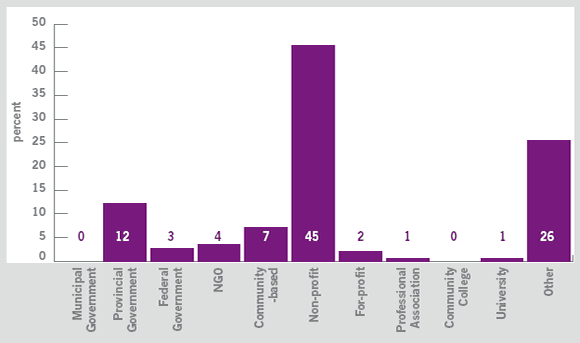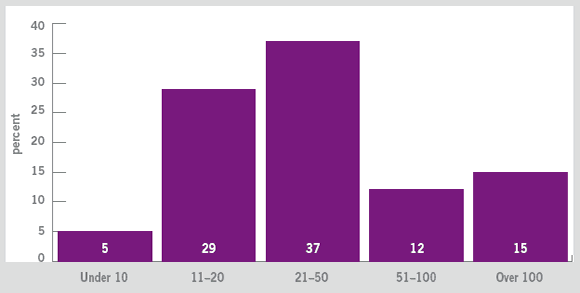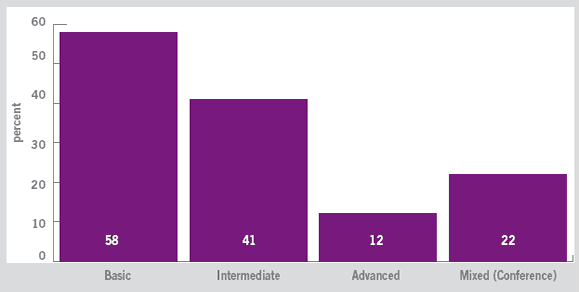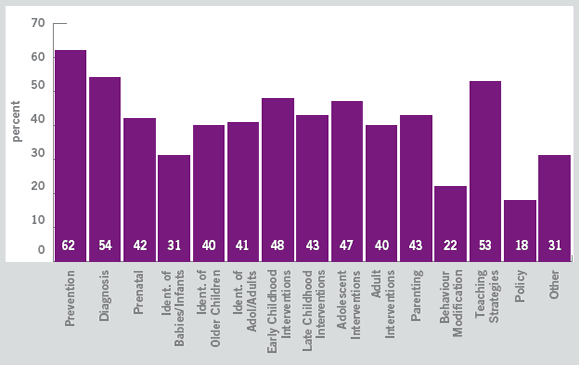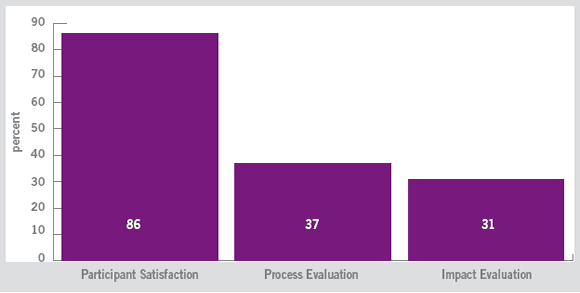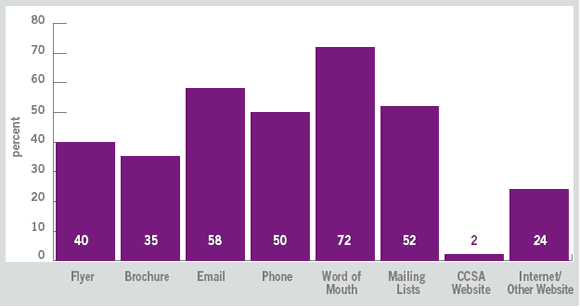Common menu bar links
Institutional links
Diseases & Conditions
Health & Safety
Research & Statistics
Agency Information
Search Box
E-mail this page
Mapping FASD Training Opportunities in Canada: An Environmental Scan
[Previous] [Table of Contents] [Next]
3 Survey Results
Training/Event Provider Information Training/Event Details
The survey asked respondents to provide information in two main areas:
- Training/Event Provider Information (related to their organization)
- Training/Event Details (specifics about the training itself)
A final section of the survey asked respondents about unmet training needs, evaluation, and ways that training is promoted. This section details the responses by individual question.
Training/Event Provider Information
This series of questions was designed to obtain basic information about the organizations participating in the survey. It will assist in identifying the types of organizations that are involved in training and whether there is a pattern associated with provision of training. The information might also identify types of organizations that are not involved in training but may be a resource for the future.
1. Type of OrganizationRespondents were asked to indicate what type of organization they represented (Table 1). From a list of eight possible responses, the majority (46%) identified themselves as "nonprofit." Twenty-five percent indicated they worked in an organization not identified on the list. Some of the responses included:
- First Nations
- parent support groups
- hospital
- territorial government
- university/college
- private business
- community networking committee
- partnership between two organizations
Very few of the respondents worked in municipal government and community colleges (less than 1%). Twelve percent of responses came from respondents who worked within a provincial government agency.
Table 1: Type of Organization
2. Geographic Location of Responding Organization
The respondent list contained names from individuals and organizations across Canada. Most responses came from organizations in British Columbia (28%), Saskatchewan (20%) and Manitoba (18%), with fewer in the Atlantic Provinces and the territories and none in Quebec. The distribution of responses is fairly reflective of the current level of activity in FASD across Canada: the Western provinces have been addressing FASD in an organized or formal manner for a number of years, whereas the rest of Canada has been slower to embrace FASD as a priority issue area. This is not to say that other provinces are not active in FASD - many provinces have become increasingly active around FASD awareness initiatives, training, diagnosis and legislation, and in many of them, formalized coalitions are forming or have been formed. Table 2 provides data on respondents' locations.
Table 2: Location of Organizations
3. Funding Sources for FASD Training/Events
Question 3 asked respondents to identify where their funding for FASD training/events came from: government, business/private sector or registration revenue (Table 3). "Government" was listed as the main source of funding (53%) while "registration" was listed by 10% of the respondents. Less than 5% received funding from the business/private sector. In the "other" category, responses included:
- personal funds used (2)
- fundraising (3)
- stipend from an organization
- grant (non-specified)
"Government" is a critical player in the funding picture for FASD. It appears that current training/events rely heavily on government support to deliver training across Canada. While some respondents indicated that their training/events require a registration fee, many do not charge a fee and if they do, it is largely to recover costs associated with the event.
Table 3: Main Sources of Funding
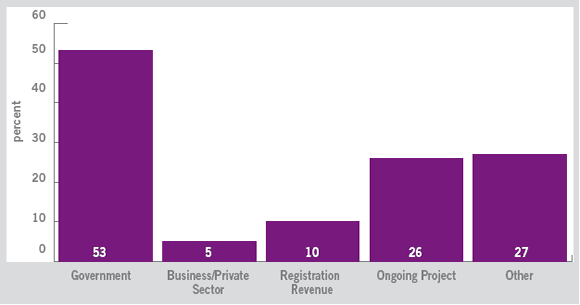
Training/Event Details
1. Duration of Training/Events
This survey was designed to gather information about training/events that were three hours or longer in duration. However, 16% of respondents indicated that their program lasted fewer than three hours. More than one third of the training lasted for seven hours or longer. Approximately 30% of the training took three to five hours.
2. Number of Times Training Offered in Survey Period
Most of the training/events (51%) occurred once as opposed to multiple times; 30% of training sessions took place four or more times. These data suggest that many of the training or events that occur across the country are single sessions, perhaps conferences or workshops that respond to a specific time-limited need.
3. Training/Event Location
In an attempt to determine the extent to which FASD training/events have embraced technology to increase availability and access for participants, the survey asked where training/events occurred. Respondents indicated that most of the training takes place faceto- face (65%). Very little training for the survey respondents is taking place online (1%). Some of the on-site venues that were identified as training locations included:
- hospitals
- community colleges
- hotels
- community centres
- at the premises of the organization requesting the training/event
- churches
Respondents indicated that sometimes the space is available free and sometimes space has to be rented.
4. Language of Training/Event
Most of the FASD training/events across Canada covered by the survey are conducted in English only (95%). Less than 5% of training is offered in a combination of English and French, French only or other languages (non-specified).
5. Training/Event Capacity
To obtain a sense of the potential capacity for training/events, respondents were asked about the maximum number of participants that their event could accommodate (Table 4). It appears that most of the sessions would be described as "moderate" in size: 37% of them accommodated between 21 and 50 participants. Respondents indicated that approximately 15% of events had attendance that exceeded 100 people (likely a conference/regional workshop).
Table 4: Number of Intended Participants
6. Attendance
Where the previous question asked about capacity, this item was intended to discover the rate of "up-take" (how many spots were actually filled) for the training/event being described. The data show that most of the training sessions met their capacity. This suggests that the training/event was achieving participation rates that matched the intended capacity. In some cases, the events appeared to be over-capacity and more people attended than were originally scheduled to attend.
7. Registration Fees
In terms of fees that are charged for FASD training/events, respondents indicated that most of the training across Canada is free (72%) or offered for less than $100 (approximately 10%). From a closer examination of responses to related questions on the survey, it is likely that organizations work together to donate resources in kind (e.g. space to hold the event, publicity, staff time) to offset the costs of offering the events. A small number (5%) of events had a registration fee between $200 and $300 and are suggestive of a conference registration fee.
8. Level of Training
As mentioned earlier, there is great variability across Canada with respect to the nature and extent of FASD activity, with the Western provinces and territories leading the way. When it comes to the level (of difficulty, intensity, complexity) of FASD training/events that all jurisdictions reported on, most described the level as "basic" (58%) (Table 5). This is also sometimes referred to as "FASD 101." Clearly, a large part of the training/events is still targeted to participants who require information and awareness about FASD at a very basic level.
Only 12% of reported training/events were described as "Advanced." As the FASD issue gathers momentum, as funding is made more available, and as the individuals working in FASD become more informed, the need to provide more in-depth training will begin to emerge. Even at the writing of this report, anecdotal comments suggest that training needs to move beyond "FASD 101."
Table 5: Level of Training Events
9. Prerequisites for Participation in FASD Training/Events
Respondents indicated that only 15% of the training/events that were offered required participants to have a background in FASD as a prerequisite to participation. This is not surprising since most of the training/events were at a "basic" level and would be designed for those with little or no background.
10. Intended Participants for Training/Events
Respondents were given a list of potential participants and asked to identify to whom their training/events were targeted. Seventeen categories of participants were listed. All categories were selected by at least some of the respondents. The data suggest that, while training is offered to a variety of audiences, those most likely to be targeted include:
- teachers/educators
- social workers
- mental health workers
- parents of FASD-affected children
Some other groups of participants were identified by respondents and included:
- judges
- lawyers
- foster and adoptive parents
- speech-language pathologists
- occupational therapists
- clinic coordinators
- individuals who have an FASD (undiagnosed)
- youth workers
- high school students
11. FASD Training/Event Topics
To determine the range of topics that are addressed by FASD training/events, respondents were given a list of potential content areas. Fourteen topics were listed and respondents could add others to the list (Table 6). The responses show that FASD training/events cover the full range of topics listed, with a few topics more common than others: those related to prevention, diagnosis, early childhood and adolescent interventions, and teaching strategies. Many fewer training/events are offered on the topic of FASD policy and behaviour modification.
Table 6: FASD Training Topics
12. Development of Training/Event
Most of the training/events offered appear to be developed in Canada as opposed to being adopted from elsewhere. Respondents reported that 97% of the training is developed within Canada. However, it is likely that the experience of other jurisdictions is being considered in the process, since respondents indicated that slightly over 30% of the training/events have been adapted from training that was developed elsewhere.
13. Accreditation
When asked whether training resulted in accreditation from an organization or professional association, respondents indicated that the majority of FASD training (84%) results in accreditation. No additional information was collected on the organization or association that grants the accreditation, or on the meaning of the accreditation. More in-depth examination of the nature of the accreditation would be needed to understand the process, need for, and value of accreditation.
14. Evaluation
A significant majority of respondents (88%) indicated that some level of evaluation is occurring in relation to their FASD training/events (Table 7). The most common level of evaluation is participant satisfaction (86%), which is generally intended to gather information on the extent to which participants enjoyed various aspects of the event.
Process and impact evaluation also occur, but to a lesser extent (37% and 31% respectively). It appears that some organizations conduct more than one type of evaluation, as percentage responses exceeded 100%.
Table 7: Type of Evaluation Conducted
15. Promotion of Training/Events
Respondents were asked to indicate how potential participants became aware of the training/events (Table 8). A list of eight options was identified, and respondents were asked to check all that applied. Interestingly, the most likely way in which participants find out about FASD training is by word of mouth (over 70%), a somewhat informal, yet obviously effective method for promoting training within the FASD community. Electronic communication (email) was the next most common way of letting people know about training/events. The least likely place to find out about training is on the CCSA website, although the Internet and other websites (possibly the hosting or sponsoring agency's website) were used to promote training/events.
More traditional methods of promotion such as distribution of flyers/brochures and communication through existing mailing lists were also identified as ways of getting the word out about training. Promotion via telephone was a method used by almost 50% of respondents.
Table 8: Promotion of Training
16. Topic Gaps in FASD Training/Events
Using the list of training topics that was provided in a previous question, respondents were asked to identify gaps in FASD current training/events (Table 9). Every training topic listed was identified by at least one and, more accurately, several respondents as having some level of gap in training. The topic that appears to reflect the greatest gap is in the area of FASD policy. Note that the earlier question on current training topics showed that this topic area was the one where the least activity is occurring. The topic area receiving the lowest number of responses was "behaviour modification." It is evident from the responses that all topic areas represent some degree of gap in the existing mix of available training throughout Canada.]
Table 9: Gaps in Current Training/Events Topic Areas
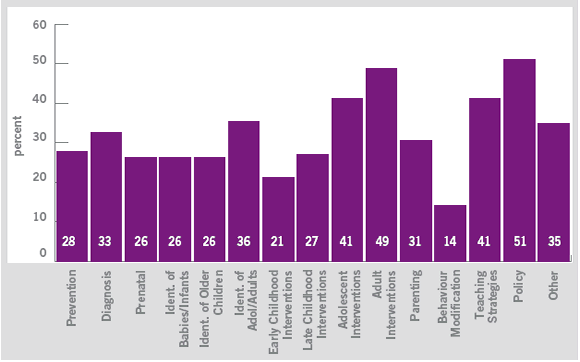
When asked to identify other topic areas covered but not listed in the survey, respondents identified the following:
- disability awareness/job coaching for potential employers
- the impact of not providing the needed supports to FASD-affected individuals and their caregivers
- implications of a preventable lifelong brain disability on the quality of life of the FASD individual and how to effectively intervene in the lives of pregnant addicted women
- ramifications of untrained individuals obtaining maternal ingestion histories from mothers that are not clinic related and are completed without pre- and postsupports, typically over the phone
- talking to birth parents about alcohol use in pregnancy...addictions
- training for affected individuals so they can understand their disability
- parenting teenagers
An issue that was articulated by one respondent related to wanting to know which Ministry is responsible for dealing with FASD. In this respondent's opinion, it appears that "no one wants to be responsible to help." This respondent also felt that the services of other ministries, such as Housing and Criminal Justice, were being inappropriately used because there is nowhere else for those who have been unable to receive service to go for assistance.
Some respondents offered additional comments about their training/events. One indicated that training/events are available in all topics but the training is limited, is neither widely available nor accessible. Another respondent concurred and added that more research and support are needed, especially in relation to education and prevention. In commenting on the quality of training/events, one respondent offered the opinion that there is no consistency of training content or application across Canada. The reach of training/events was an issue for a respondent who exclaimed that although all topic areas are being addressed, all areas needed more coverage.
17. Who Still Needs Training in FASD?
When asked who still needs training in FASD, the respondents replied overwhelmingly that there is need for training in every category that they had to choose from on the survey list (Table 10). Seventy percent or more of the respondents selected almost all of the 17 categories listed. The categories with the highest need according to the respondents are: teachers/educators, physicians, vocational/employment counsellors and policymakers. Furthermore they listed a number of additional sectors/population that, in their estimation, require training, including:
- lawyers, judges
- landlords, housing officials
- chief executive officers (CEOs) of the organizations serving people with either developmental or mental health issues (while the title "CEO" was used specifically, this may be a reference to "administrators" in general)
- psychiatrists
- employers
- political and First Nation leaders and decision makers
- although many individuals receive training, much more and better integrated opportunities for professional training are needed (i.e. during professional training as well as follow-up professional development)
- for students in schools so they can understand classmates
- elected officials (Band Council)
Table 10: Groups That Need to Be Trained
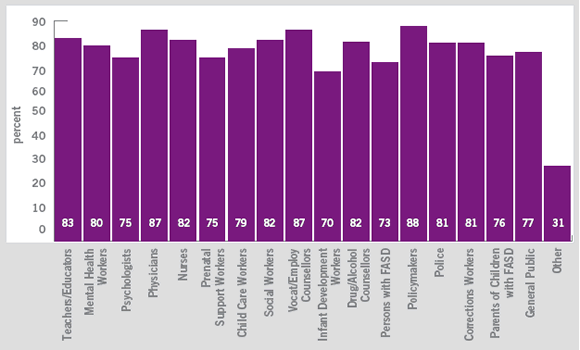
Several respondents took the opportunity to frame the issue within a larger context by offering the following comments:
- We are really just beginning this work.
- FASD training is an ongoing venture that needs to be offered in different environments, including professional development, post-secondary, K-12 classrooms and other learning environments.
- Absolutely all segments of society need to understand FASD.
One respondent summed it up by saying that, "Training will need to be ongoing for all people forever."
[Previous] [Table of Contents] [Next]

